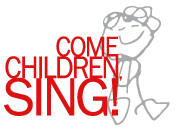Level 4 Activities take your child to a much higher level of music learning with music reading. As with language, your little one grows into reading music through immersion, interaction, babble, being read to, imitating reading behaviors, and ultimately bringing meaning to print. At every level, your child’s rhythm knowing informs tonal knowing. Rhythm reading is therefore presented before tonal reading. Rhythm Reading is introduced in Class 10 through reading music to your little one, much as you read storybooks to your child. This posting currently includes Level 4 Activities through Class 12. CCS Curriculum Overview
Rhythm Reading
CCS Rhythm Reading Activities represent in print your little ones rhythm knowing. Rhythm Syllables give your child a language with which to read rhythm. Contrary to popular belief, rhythm reading is not a process of determining the time values of notes, but rather one of bringing rhythm knowing to notation.
Read Storybook—Read the little “Rhythm Storybook” to your child over and over just as you do favorite storybooks. Find a place on the shelf just for “Music Storybooks,” where your child can access the “Rhythm Storybook,” request at will that you read it, or read it by himself.
All By Myself—Encourage your little one to read the “Rhythm Storybook” to you. As you do with favorite storybooks, start the story, (which will set up the meter), and continue reading, leaving room for your child to finish your phrases. Keep the little “Rhythm Storybook” on a special shelf where your little one can access it at will and “read” it as he does favorite storybooks. You may hear more chanting from your little one than ever before as he independently “reads” his little “Rhythm Storybook.”
Computer Master—Give your little one a chance to be the computer master. Demonstrate how to start the Reading Activity and how to click from the Rhythm Story to the Rhythm Storybook and back. Working the computer will surely compel your little one, but don’t underestimate the attraction of Reading Rhythm.
Storybook Shelf—Print out each Rhythm Storybook and put on a shelf where your child can access each as easily as other storybooks. Encourage your little one to pick a Rhythm Storybook for you to read, or invite your child to read one of the Rhythm Storybooks to you. Start the meter of each story if your little one will let you participate, establishing the meter in your little one’s musical mind. You may find that your child will chant one meter while looking at another, or “read” patterns that are not in notation. Let whatever is in that little musical mind guide the reading, rather than what is on paper.
Rhythm Writing
CCS Rhythm Writing Activities provide opportunity for your little one to look over the shoulder of one writing rhythm, and to write music himself. Rhythm syllables provide the link for your children to represent his rhythm knowing in print. Writing rhythm is a process of writing what is on the musical mind, not one of drawing notes.
Composer in Residence—Print out the staff paper and encourage your little one to “write music.” Chant in Rhythm Syllables to set up the meter for your child. Encourage whatever marks your little one makes and then ask him to read what he has written. Chances are his writing won’t look much like what he is chanting, but encourage all attempts.
Commissioned Compositions—Invite your little one to write music for loved ones or favorite stuffed toys or dolls. Encourage your little composer to read to the loved one or toy the music he has written. Reinforce the meter in Rhythm Syllables as needed.
Tonal Reading
CCS Tonal Reading Activities represent your little ones tonal knowing in print. Tonal Syllables provide a language with which to read tonal. Contrary to common notions, tonal reading is a process of bringing tonal knowing to notation, not one of naming notes, lines or spaces.
Tonal Storybook—Read the “Tonal Storybook” to your child over and over just as you do favorite storybooks. Include the Tonal Storybook on the shelf with Rhythm Storybooks, where your child can access each, request at will that you read it, or read it by himself.
Independent Reader—Encourage your little one to read the “Tonal Storybook” to you. Start the story, setting up the tonality and meter, and continue reading, leaving room for your child to read along or finish your phrases. Encourage all reading behavior, without concern for accuracy. You may hear more tonal response that usual as your little one “reads” independently. Or, you might hear only rhythm while your little one “reads” tonal.
|

